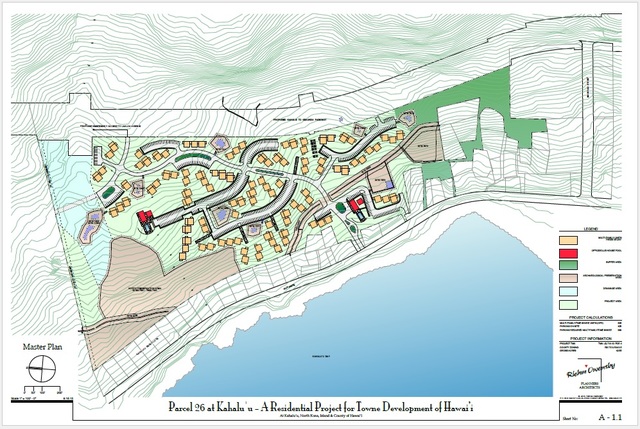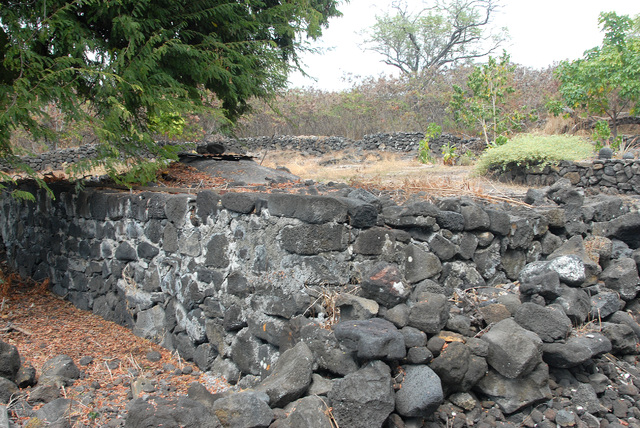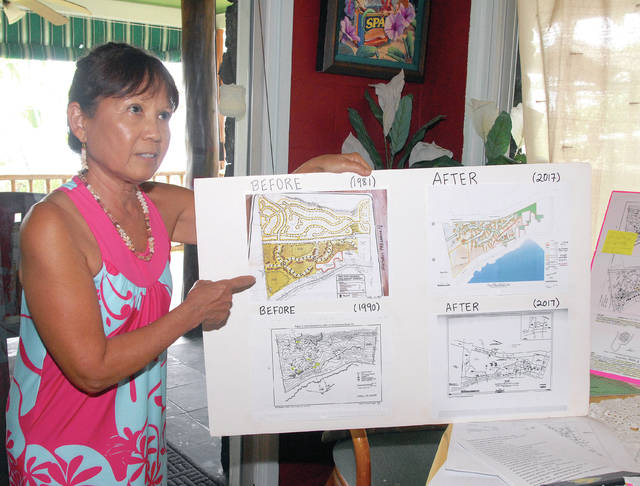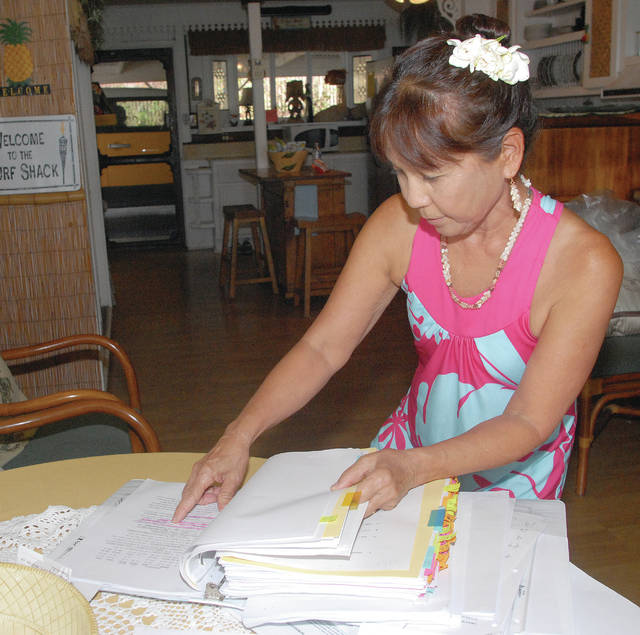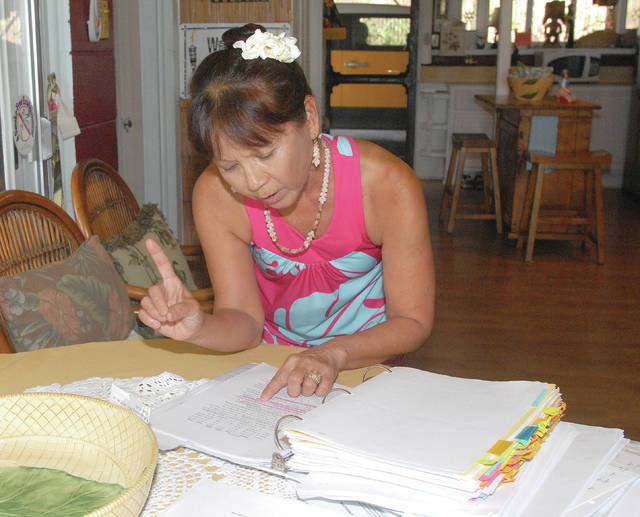Major Kahaluu development draws concerns
KAHALUU — For generations, the Kahulamu family has laid their loved ones to rest at the family cemetery in Kahaluu.
ADVERTISING
Mitchell Fujisaka’s father is buried there, as are his grandparents, great-grandparents as well as numerous extended family members, the 80-year-old said at the site Thursday.
And that’s just what’s been marked by headstones.
Even the oldest grave markers don’t convey the full history of this site, which the Kahulamu family has used “from way back then till now.”
“The thing is what you see on top here is marked,” he said, surrounded by memorials. “But you don’t see what’s underneath. So it’s grave on top of grave, burial on top of burial.”
Fujisaka said he’s also been told of burials in a lava tube that runs just below the property.
“And we still bury people,” said Gerry Kahulamu, adding that the family still puts cremated remains on the property.
For Fujisaka, it’s important to keep the family together.
“If I take my grandfather, I bury him in Hilo for instance, my grandmother is here,” he said. “When I come to visit my grandmother, I neglect my grandfather. I go to Hilo, I visit my grandfather, I neglect my grandmother.”
“Here, they’re together,” he said. “I can put my hands on both.”
But the cultural and historic importance of Kahaluu, the ahupuaa just north of Keauhou and location of the popular Kahaluu Beach Park, extends beyond the gates to the family cemetery. There are burials and significant sites all throughout the area, they said.
306-unit development
But family members and another Kahaluu resident say cultural sites here are under threat from a proposed 306-unit condominium development planned by Ocean Villas at Kahaluu Bay LLC. The current plan is to develop and sell the units as timeshares, according to the final environmental assessment, but could be sold as whole units depending on the market.
In the final environmental assessment for the project, the applicant is identified as “Towne Development of Hawaii Inc.” The applicant for the special management area permit is identified as Ocean Villas at Kahaluu Bay LLC in planning commission documents. Both companies are listed at the same mailing address, according to the Department of Commerce and Consumer Affairs.
Plans for the development have led to a contested case — with a hearing scheduled to start Monday — from Kahaluu resident Simmy McMichael, whose property borders the proposed project area.
“This place is really spiritual and I never knew how spiritual it was, because I never knew what was back there,” McMichael said at her property Thursday. “And I just knew; I had the feeling that it was special. And when I found out how special, I said, ‘I can’t; I cannot be quiet.’”
The county’s Leeward Planning Commission has reserved two days for the hearing — and a third if necessary — at the West Hawaii Civic Center. Monday’s hearing will start at 8 a.m.
The commission granted McMichael’s petition for a contested case hearing last April at a packed commission meeting in which more than 30 people testified.
In her petition, McMichael said she has “a deep concern for the proper development of land,” noting that the area is part of the Kahaluu Historic District, which is registered in the National Register of Historic Places.
The historical and cultural resources in the project area haven’t gone unacknowledged by the developer. A final environmental assessment for the project cited a survey that found 58 sites consisting of 247 features, which include platforms, mounds, a burial crypt and a petroglyph among others.
The sites also include the Great Wall of Kuakini, constructed by the first royally appointed governor of the island, according to the assessment. The wall was built in the first half of the 19th century to keep cattle from destroying agricultural plots in the area.
All 58 sites identified were deemed significant but only some sites, including the wall and those inferred to be a burial or possible burial, were marked for preservation, while others were marked for “data recovery.”
To accommodate the 20 sites to be preserved, the project has carved out preservation areas from the project site and are indicated on proposed maps of the development.
The remaining 38 sites, including some inferred to have been used for agriculture and habitation, face “controlled destruction,” which “will be monitored to ensure that significant data is collected, if encountered,” the assessment states.
The assessment also outlines procedures for any archaeological remains or burials uncovered during future phases of the development.
Some burials not well known
The assessment states that despite a thorough surface survey, no unaccounted for burials have been identified, nor were any cave openings that could lead to a burial.
But Fujisaka argues the secrecy of burial sites was key to the traditions surrounding the practice.
“The only one that knows where that person’s gonna be buried are the people that are assigned,” he said.
The idea that everyone is buried in a cave, he said, is a myth.
“No, no, that’s wrong,” he said. “If that person was familiar with a tree or a rock or something, they would take that person and bury him there or bury her there.”
Concerns addressed
Bill Moore, a planning consultant for Towne Development, pushed back against the notion that the developers haven’t been sensitive to cultural concerns.
The area eyed for development, he said, has been part of the county’s general plan for resort developments since the plan’s adoption.
“The zoning is appropriate,” he said. “We have done all of the archaeological studies and requirements that have been placed on us by the State Historic Preservation Division, so I do take exception that we do not have concern for the historical and cultural sites.”
When the final environmental assessment for the project was published, the section dedicated to mitigating the impacts of the project included an additional five bullet points addressing the handling of cultural sites at the development site beyond what was included in the draft report.
Those points referenced the Kahulamu family, the cemetery site and burials not recorded in the initial inventory survey.
In response to concerns about the development’s proximity to the family cemetery, Towne Development revised its plan to create a “buffer area” around the family’s property.
With that buffer in place, there won’t be any development activities within 150 feet north of the Kahulamu kuleana lands, nor will there be any development activities in any part of the Towne property south of Kahulamu property.
“This measure ensures that construction will not take place near to the Kahulamu graveyard and will not encroach upon or diminish the character of those burials,” stated the assessment.
In sum, the assessment said, the revised plan includes almost 19 acres as either permanent preservation areas and open space, including the buffer.
Gerry Kahulamu said she hadn’t seen anything about the proposed buffer in writing but that it wouldn’t change her position.
“Personally, I don’t want to see any development,” she said. “This isn’t the area. It’s already too crowded.”


